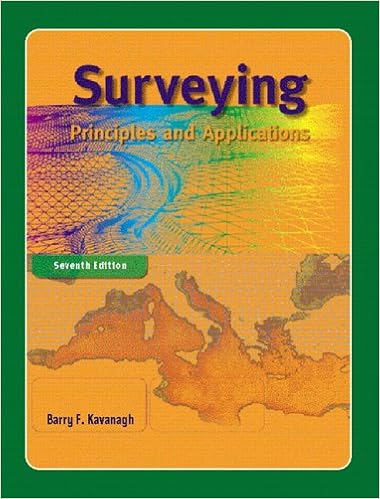
Free Downloads Surveying: Principles And Applications (7th Edition)

For freshman-junior level Civil Engineering courses in surveying/geomatics, including photogrammetry and hydrographic surveying. This text presents a clear discussion of surveying principles, and applications for mapping and engineering surveys. It has a good selection of problems that illuminate and reinforce concepts, as well as providing up-to-date information on the latest technological innovations. Real-world emphasis is key to the continued success of this text and the success a student has in understanding surveying concepts. So real world is this text that graduates often arrive for their first day of work carrying it. Suitable for construction, civil technology, civil engineering programs, and general surveying programs. INSTRUCTOR RESOURCES: Instructor Manual with Powerpoint (Contains over 300 Slides)

Hardcover: 816 pages
Publisher: Prentice Hall; 7 edition (June 17, 2005)
Language: English
ISBN-10: 0131188623
ISBN-13: 978-0131188624
Product Dimensions: 7.9 x 1.4 x 9.5 inches
Shipping Weight: 3.1 pounds
Average Customer Review: 4.3 out of 5 stars See all reviews (7 customer reviews)
Best Sellers Rank: #1,332,782 in Books (See Top 100 in Books) #109 in Books > Engineering & Transportation > Engineering > Civil & Environmental > Surveying & Photogrammetry #3646 in Books > Crafts, Hobbies & Home > Home Improvement & Design > How-to & Home Improvements > Design & Construction #3984 in Books > Engineering & Transportation > Engineering > Construction

I've been teaching from this book for five years, so I'm obviously prepared to endorse it. I have required it for both civil engineering technology and civil engineering science students, although it is most useful to the former.Several competing texts in surveying are in their ninth (or greater) editions. Ordinarily in academia, this is a testament to the staying power of the author's work. The surveying profession, however, still relies upon texts that have long out-lived their original authors, who have since retired or passed away (e.g., Bouchard, Brinker, Brown).In the area of boundary control and legal principles, the seminal ideas of Brown are still the standard. In measurement techniques, however, much has changed. Tape corrections, for the typical civil engineer, have been relegated to an obscure niche in surveying trivia. GPS and GIS should be separate and substantial chapters in a good general surveying reference. Current general tomes, however, are far from the cutting edge.Kavanagh and Bird have provided in their fourth edition a description of GPS that amounts to 12 pages. GIS is afforded even less space. The text remains a good practical reference for civil engineers on traditional topics, without digressing into treatment of esoteric subjects, but as GPS continues to make inroads to the mainstream of measurement technique, and GIS becomes the standard by which surveying models will be constructed, the demand for a fifth edition that gives these topics expanded treatment will increase.
I have been a Civil engineering Instructor for the past five years and have used this text also. The text is quite handy for the intermediate to advanced level of Civil Engineeering students. This text should not be used for the beginner due to it's higher level of content. If this is to be used for the introductory level, the instructor should have a copy only and use it a guide. More students in the introductory phase wash out after reading a few chapters.
For $20 total (no prime shipping), you get a college text that addresses the relevant issues of practical surveying. As an older edition, it might or might not be OK for your current class, but for work on your own it sure beats the cost of the current edition! It arrived way earlier than projected.
I had used the standard study materials, and due to various reviews by others who had taken the test, decided to supplement my review by studying the topics covered in more detail with this reference, having not taken a surveying course in my undergraduate studies. The material is clear and concise (for a novice like myself), and aided my preparation greatly.
Surveying: Principles and Applications (7th Edition) Surveying with Construction Applications (7th Edition) What was that Formula?: Surveying Formulas (Surveying Mathematics Made Simple) (Volume 11) Charts & Graphs (Surveying): Reference Guide (Surveying Mathematics Made Simple) (Volume 15) Charts & Graphs (Surveying): Reference Guide (Surveying Mathematics Made Simple Book 15) Surveying: Principles and Applications (8th Edition) Surveying with Construction Applications (6th Edition) Principles and Practice of Surveying Practice Exam Surveying Principles for Civil Engineers, 2nd Ed The Complete Works of Herbert Spencer: The Principles of Psychology, The Principles of Philosophy, First Principles and More (6 Books With Active Table of Contents) Ergonomics: Foundational Principles, Applications, and Technologies (Ergonomics Design & Management Theory & Applications) Cryptography and Network Security: Principles and Practice (7th Edition) Student's Solutions Guide to Accompany Discrete Mathematics and Its Applications, 7th Edition Computer Applications in Hydraulic Engineering 7th (Seventh) Edition BYMethods Datums and Map Projections: For Remote Sensing, GIS and Surveying, Second Edition GPS Satellite Surveying, 2nd Edition Elementary Surveying: An Introduction to Geomatics (12th Edition) Elementary Surveying: An Introduction to Geomatics (13th Edition) Elementary Surveying: An Introduction to Geomatics, 10th Edition Surveying Fiberglass Power Boats: 2nd Edition



